Fall 2022 Course Guide
Welcome to the Fall 2022 Course Guide for the Department of Art and Art History!
We invite you to browse all the offerings and let us know if you have any questions. For individual courses, please reach out to the professor. For other questions about your major, minor, or our curriculum more generally, please contact your major advisor or any of us listed below. Department faculty and staff are happy to answer your questions and discuss your options by email or appointment.
Director of Undergraduate Studies in Art History – Prof. Ian Bourland
Director of Undergraduate Studies in Studio Art – Prof. John Morrell
Director of MA Program in Art and Museum Studies – Prof. Lisa Strong
Department Chair — Prof. Elizabeth Prelinger
Department Coordinator – Em Aufuldish
Studio Art Courses
Design
ARTS 100-01 – Design I
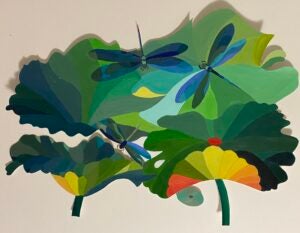
Camouflage Project: In Design I, we cover color mixing and color theory. In this project, by Elena Zheng, the students were asked to think about the idea of camouflage and how to integrate two or more natural or man made objects by thinking about their color placement and arrangement.

Experimental color compositions: In this project (seen here: Professor Dowley’s demonstration) students use their own photographs of architectural spaces to develop two simplified color compositions. One of the compositions will be monochromatic (one primary color is chosen as a starting color) and the other is developed from complimentary colors.

Paper Cutting: Students learn to cut intricate designs using only paper and x-acto knives. Students develop their images from their own photography and from drawings.(student work: Cornelia Thomas)
ARTS 100-01 — Design I This is an introductory art studio course. Using drawing, painting, sculpture and photo materials, students learn the principles and elements of design necessary to communicate and express themselves visually. Special topics include collage and paper cutting. ARTS 100 is required for all art majors and is recommended for art minors and as an elective for students interested in exploring the discipline of studio art.
This course is taught by Professor Michael Dowley.
Drawing
ARTS 110-01 & 110-02 – Drawing I: Visual Language
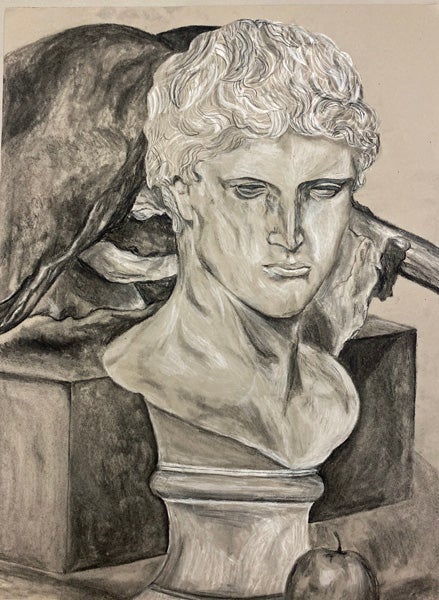
Subtractive Drawing by Miranda Woodruff

Final Project by Katherine Smith
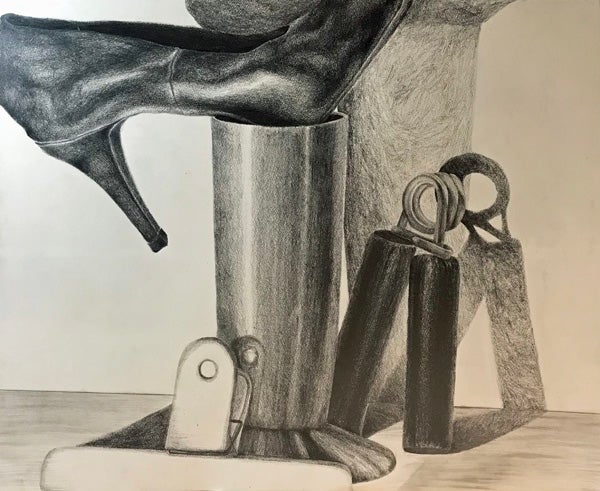
Value Study #2 by Rebecca Fernandez
ARTS 110-01 & 110-02 – Drawing I: Visual Language This course is designed to introduce basic fundamentals of drawing, with an emphasis on perceptive and technical skills. Basic art elements, and principles of art are explored as they relate to graphic expression. Additionally, this course is designed to develop basic drawing skills using a variety of media and techniques, and to become knowledgeable of various topics, and vocabulary in drawing such as line, tone, perspective, proportion, and composition. Another purpose of this course is to develop basic critical skills in visual art, and to expand elements of visual and critical thinking, and visual vocabulary.
This course is taught by Professor Tom Xenakis.
ARTS 110-03 – Drawing I: Visual Language
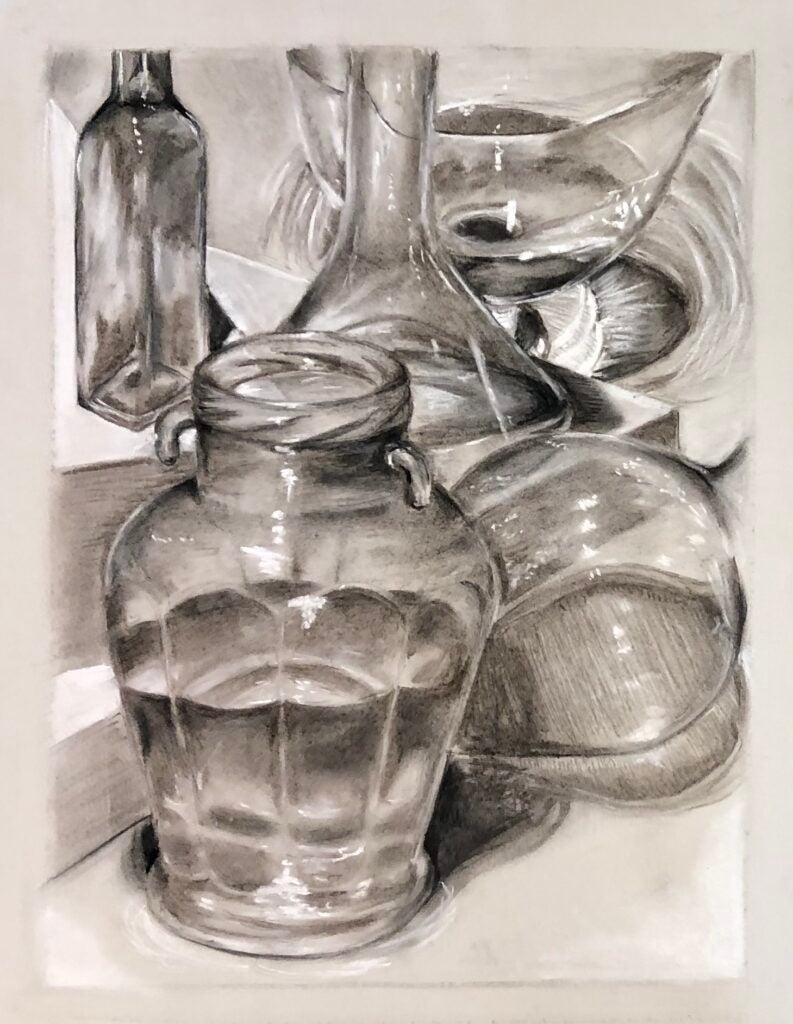
Jenna Royson, Reflections

Kent Hall, Flower study

Jade Murphy, Ballet Slippers
ARTS 110-03 – Drawing I: Visual Language In this course, students explore drawing as a graphic means to process the world around them. The class starts with the fundamentals of composition, and how to use light and shadow to describe form. We then look at line as a means of discovery and expression, along with other techniques of rendering form, space and texture. Projects range from still life and interiors to studies of nature, animal skulls and the portrait/figure. Students are approached on an individual basis as well as through group discussions, slideshows, demonstrations and critiques. “Learning to draw is really a matter of learning to see.” – Kimon Nicolaides.
This course is taught by Professor Ann Schlesinger.
ARTS 110-04 – Drawing I: Visual Language
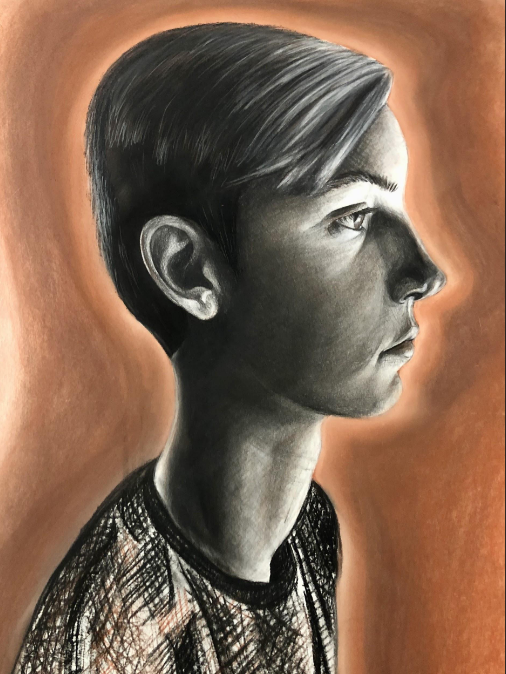
Peris Lopez, Profile Portrait Drawing

Anastasia Wass, Drawing Glass
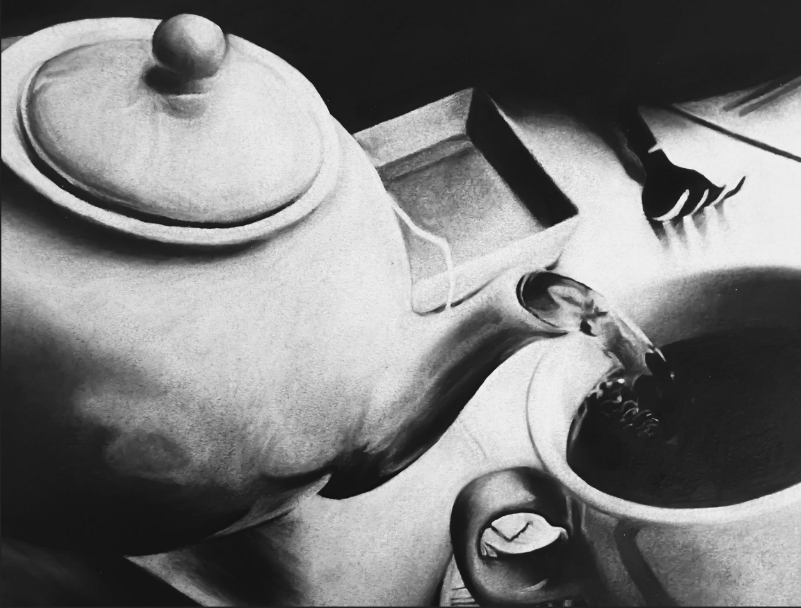
Julia Gigante, High Contrast Drawing
ARTS 110-04 – Drawing I: Visual Language Gustav Klimt once said, “Art is a line around your thoughts.” In this course, students will use drawing as a means of creative reflection and as a means to process the world around them. Students will draw inspiration for their work from their personal-history and surrounding environments. They will learn to see the world from a new perspective, and with fresh eyes. This course will begin with foundational material, building step by step in complexity. Students will use checklists to help them to develop and fix line drawing, shading, and composition. Understanding that students have different levels of drawing experience, I work with each student individually to help them improve. Using interactive group critiques and one-on-one feedback from me, all students will gain valuable feedback on their drawings. A variety of drawing processes and techniques will be covered. Subjects covered will include still life, landscape, portraiture, the figure, and architectural perspective drawing.
This course is taught by Professor Mark Anderson.
Printmaking
ARTS 120-01 — Intro to Printmaking

Grace Nguyen
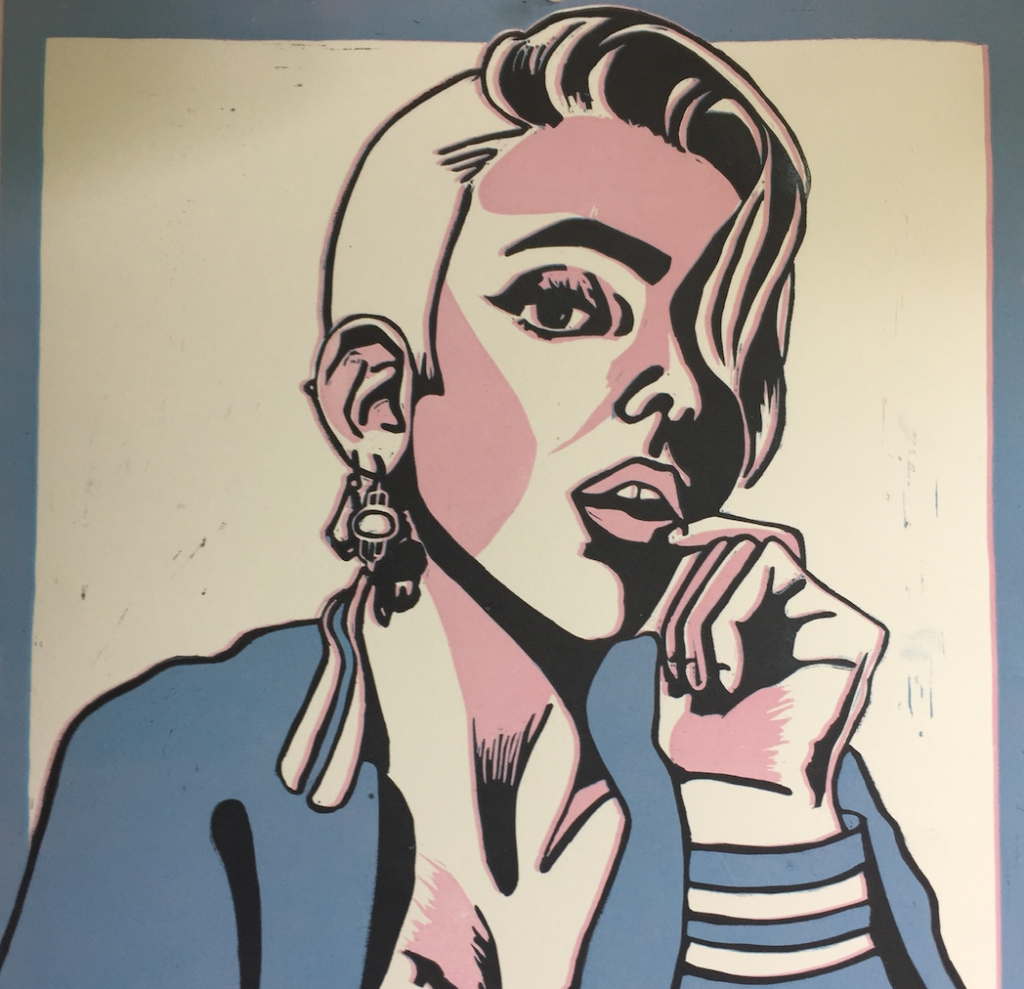
Tyler McConville

Grace Nguyen
ARTS 120-01 — Intro to Printmaking This course utilizes traditional hand printing of relief images from Linoleum plates. Test plates are done in color and B&W. Folds and simple bookmaking are presented as options. After learning safe cutting, registration and printing methods, students are encouraged to pursue their own personal imagery. Critiques and view and response of videos and online print related sites is required.
This course is taught by Professor Scip Barnhart.
ARTS 170-01 — Art of the Book

Olivia Tatarian

Jordyn Jones
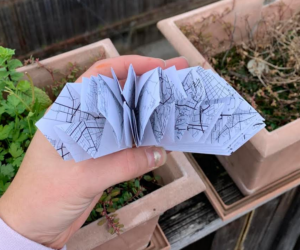
Olivia Tatarian
ARTS 170-01 — Art of the Book This course explores the practice and creation of unique artist books. Multiple bindings, sewing, folds, cutting methods, and techniques are taught to prepare students for personal expression through hand made books.
This course is taught by Professor Scip Barnhart.
Photography
Darkroom
ARTS 130-01 – Photo I: Darkroom
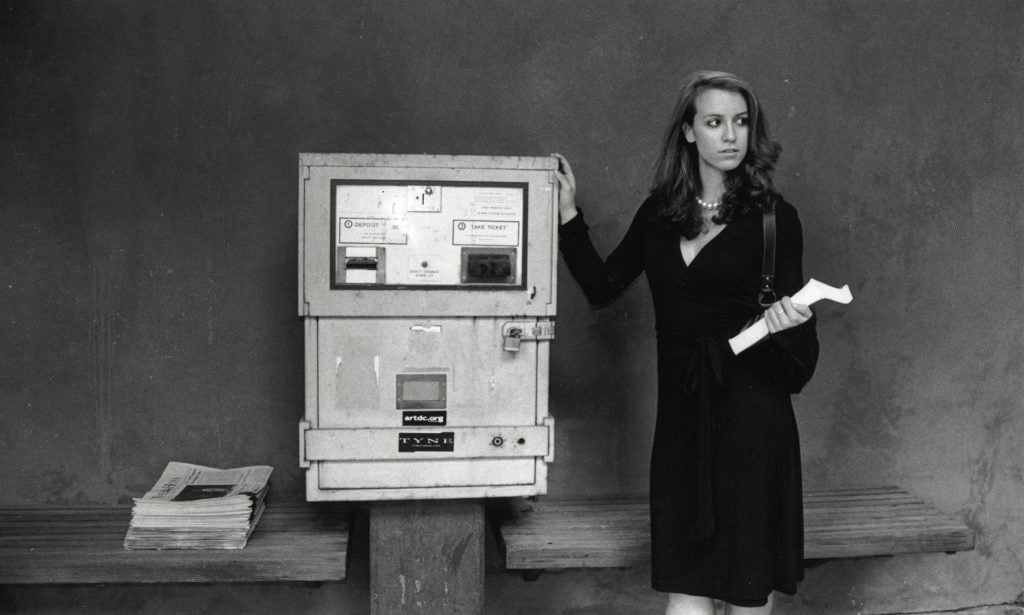
Student work.

Student work.
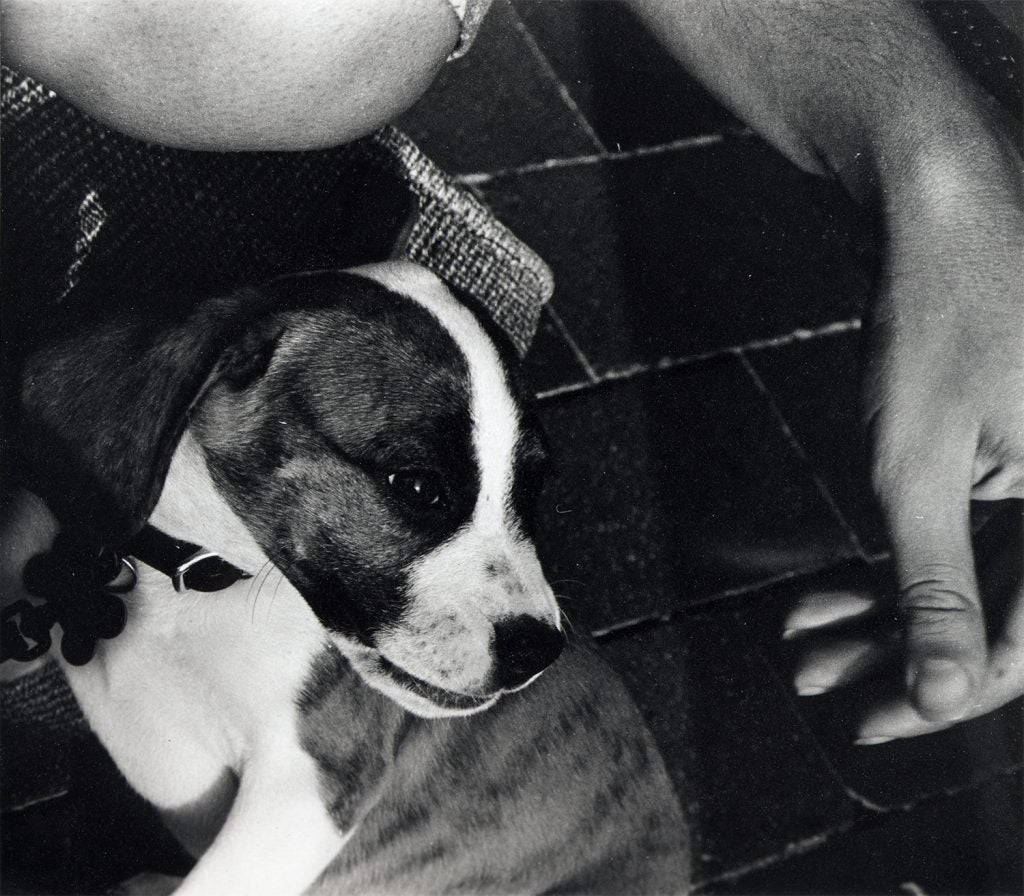
Student work.
ARTS 130-01 – Photo I: Darkroom This intro-level course introduces students to the basics of film and darkroom photography, including camera use and functions, film processing, and printing images in the darkroom. Through lectures, demonstrations, and hands on practice, students learn about composition and aesthetics, exposure, and print qualities. The class also uses presentations and guest speakers to explore the history of photography and contemporary practices. No prior experience necessary.
These courses are taught by Professor Bruce McKaig.
ARTS 130-02 – Photo I: Darkroom

Photo credit to Kelly Carr.

Photo credit to Kelly Carr.

Photo credit to Kelly Carr.
ARTS 130-02 – Photo I: Darkroom This course has been designed for students who do not have any technical understanding or previous experience with traditional black and white film photography. It will cover camera operations, film processing, enlargement printing, and presentation methods; students will expose, develop, and print all of their own images. Information will be conveyed through traditional readings, demonstrations, and hands on experience with the camera out in the field and print chemistry in the darkroom.
This course is taught by Professor Kelly Carr.
Digital
ARTS 131-01 – Photo 1: Digital
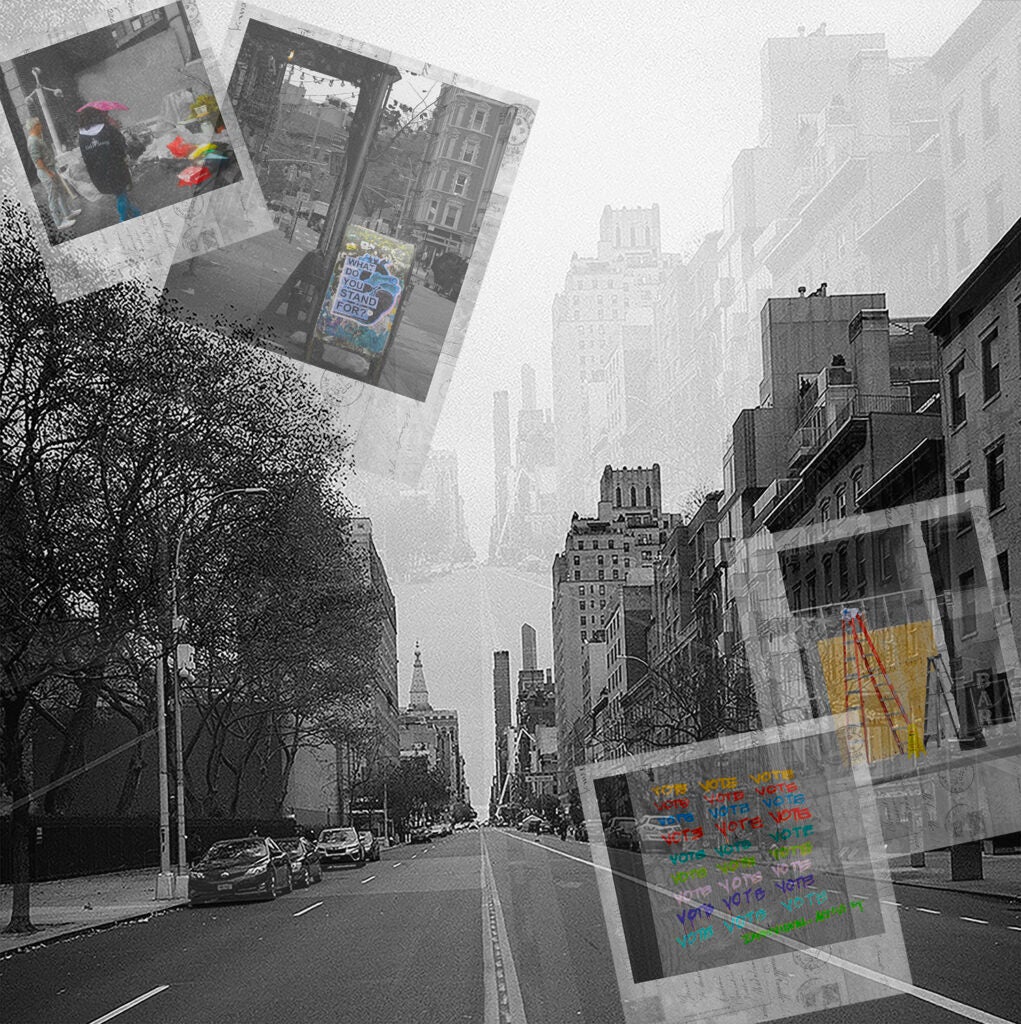
Andrea Cano, Final portfolio work

Carl Wegner, Final portfolio work
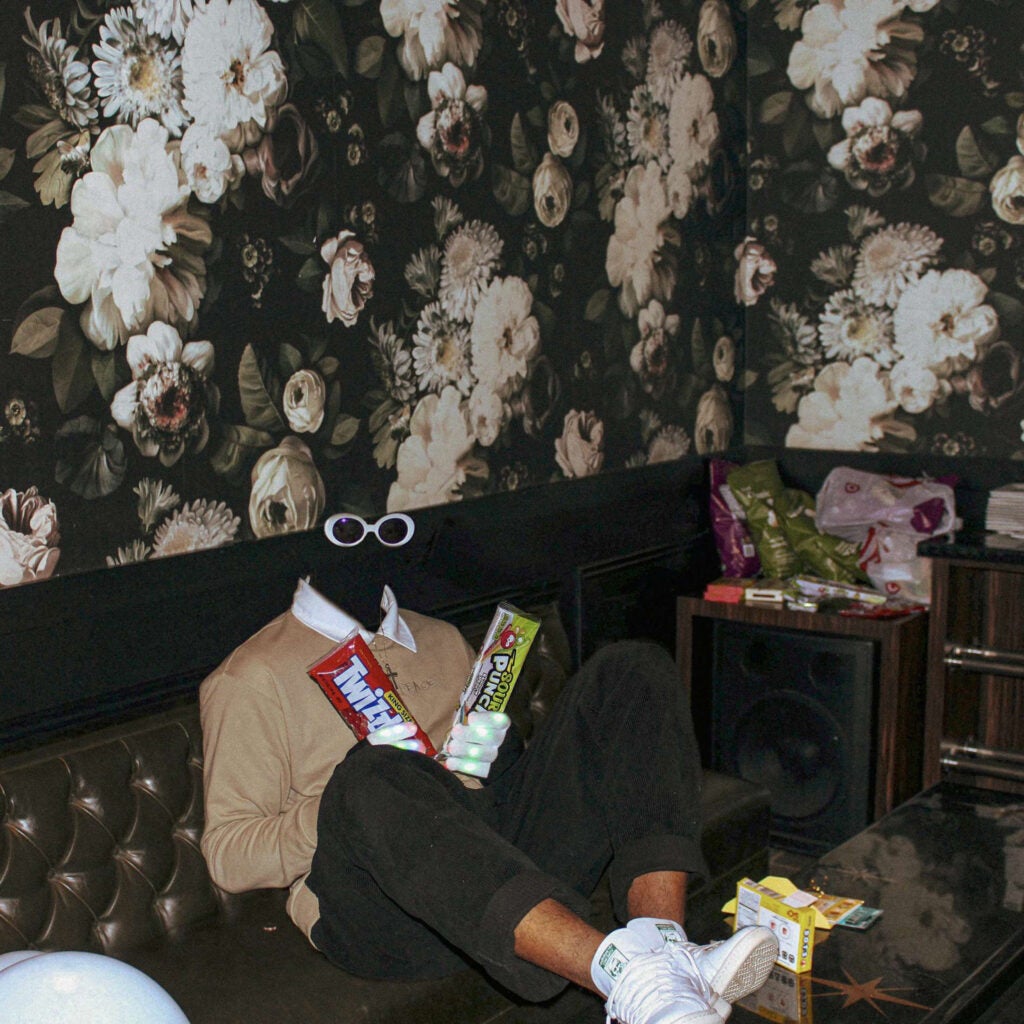
Final portfolio work.
ARTS 131-01 — Photo 1: Digital Photography plays a predominant role in how we explore and express ourselves, how we connect. Even after the pandemic, that will still be true. This class explores how the craft challenges, the cultural framework, and the photographer’s perspective are potential tools to help be better at making and understanding photographs. The sample images are student’s final portfolios from Fall 2020. I am humbled by how much progress the students made even as we explored without the possibility of brainstorming face-to-face around a table.
These courses are taught by Professor Bruce McKaig.
ARTS 131-02 – Photo 1: Digital
ARTS-131-02 — Photo 1: Digital This is an introductory digital photography studio art course designed to develop the hands-on skills necessary to produce and identify the elements of a good photograph and to acquire a thorough working knowledge of digital equipment. Students will gain an understanding of the aesthetic and technical areas of photography as a fine art. Class lectures, discussions, and digital lab assignments will deal with photographic composition, criticism and history, camera and paper types, and printer systems. Fundamental knowledge of computer programs such as Photoshop will be covered for students to edit and print their work. Students enrolled in studio courses must devote a minimum of 4 to 6 hours per week outside of class to develop and complete assignments. Through the analysis of the history of this medium, this class involves the study of photography as a metaphor for the human condition with students engaging in self-reflection and questioning through analysis, inquiry, dialogue, and creation.
This course is taught by Professor Brady Robinson.
ARTS 131-03 – Photo 1: Digital

Abel Teffra, Fall 2020

Valerie Sanchez, Summer 2020

Leo Arnett, Summer 2020
ARTS 131-03 — Photo 1: Digital This is a basic digital photography studio art course designed to develop the hands-on skills necessary to produce and identify the elements of a good photograph and to acquire a thorough working knowledge of digital equipment. Students will gain an understanding of the aesthetic and technical areas of photography as a fine art. Class lectures, discussions and digital assignments will deal with photographic composition, criticism and history. Fundamental knowledge of computer programs such as Photoshop will be introduced in the semester to develop photographic imagery.
This course is taught by Professor Kelly Carr.
BACK TO TOP
Sculpture
ARTS 140-01 & 140-02 – Sculpture I
There are two sections of 140, at different times.

Sidney Lee, Modeling from life
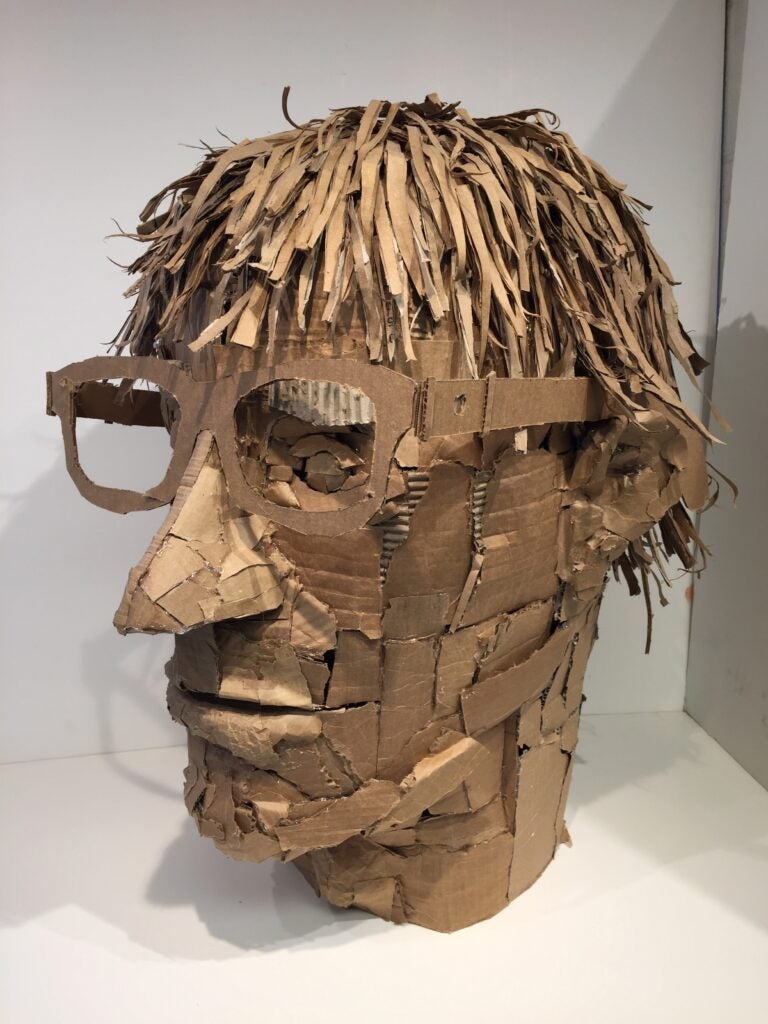
Sean Letendre, Cardboard self-portrait

Corine Forward, Spring 2019, Micro Monument Assignment
ARTS 140-02 & 140-03 – Sculpture I This course offers students the opportunity to exercise their creative drive and objectify their ideas as three-dimensional form. Students work in traditional and contemporary methods and materials. During the semester there are three thematically driven projects that simultaneously introduce new materials, processes, and formal consideration. Sculpture is an introductory course with projects that range from modeling a representational form in clay, creating abstract sculptures with recycled materials, and developing sculptures based on a conceptual prompt. All technical processes in this course are introductory and require no previous experience in art making.
This course is taught by Professor Evan Reed.
Painting
ARTS 150-01 – Painting I: Oil

Kristina Ravensbergen, Portrait.

Lola Bushnell, Landscape painting.
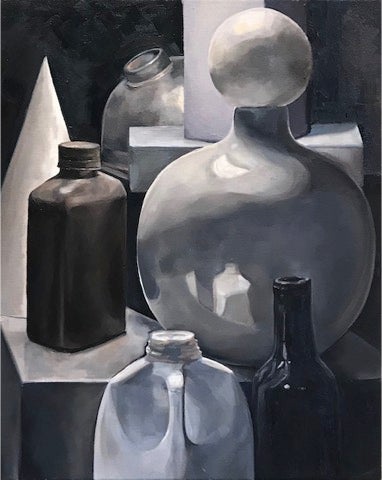
Sonya Fares, Limited palette painting.
ARTS 150-01 — Painting I: Oil Edward Hopper once said, “If I could say it in words there would be no reason to paint.” In this course, students will use paint as a means of creative expression and as a means to explore their individual interests. Students will gain inspiration for their work from their personal-history and surrounding environments. They will learn to see the world from a new perspective, and with fresh eyes. This course will begin with foundational material, building step by step in complexity. Students will explore color theory and composition. Understanding that students have different levels of painting experience, I work with each student individually to help them improve. Using interactive group critiques and one-on-one feedback from me, all students will gain valuable feedback on their drawings. A variety of painting processes and techniques will be covered. In addition to still life, students will be able to do landscape and figure paintings. As a remote course, resources will include prerecorded demonstrations, live-recorded demonstrations, slideshow lectures, and short films about artists.
This course is taught by Professor Mark Anderson.
ARTS 150-02/03 – Painting I: Oil

Zoom Black and White Demonstration
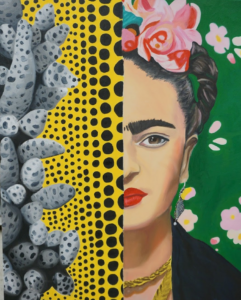
Melissa Gonzalez, Collage Painting Project
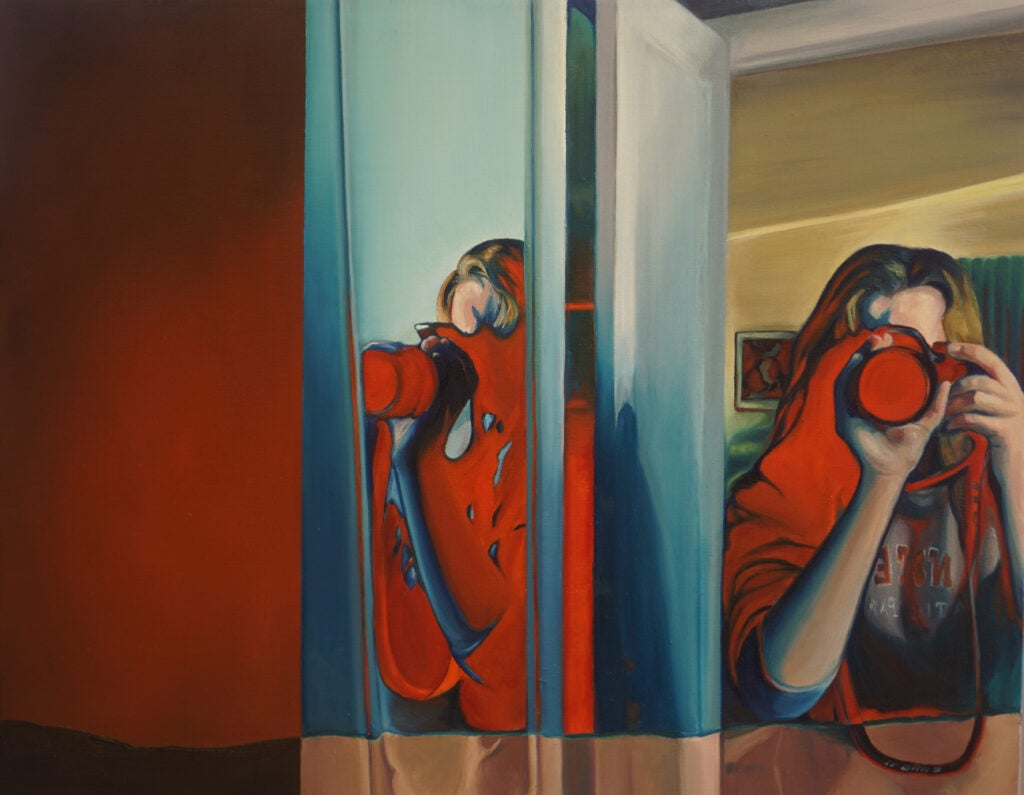
Susanna Hermann, Multiplicity Painting Project
ARTS 150-02/03 – Painting I: Oil This is an introductory painting course that teaches the basic techniques of painting. Students learn to paint from observation, in a manner that results in a realistic depiction of the subject. However, the goal of this course is not to make copies, but to strike a balance between an art historical approach to painting with a contemporary one – fostering an environment that encourages students to think creatively and to experiment with the paint and the subject. This is achieved through live demonstrations, artist slide lectures, group, and individual critiques.
This course is taught by Professor Scott Hutchison.
ARTS 151 – Painting I: Acrylic

Painting by Katie Flynn

Painting by Dane Tedder
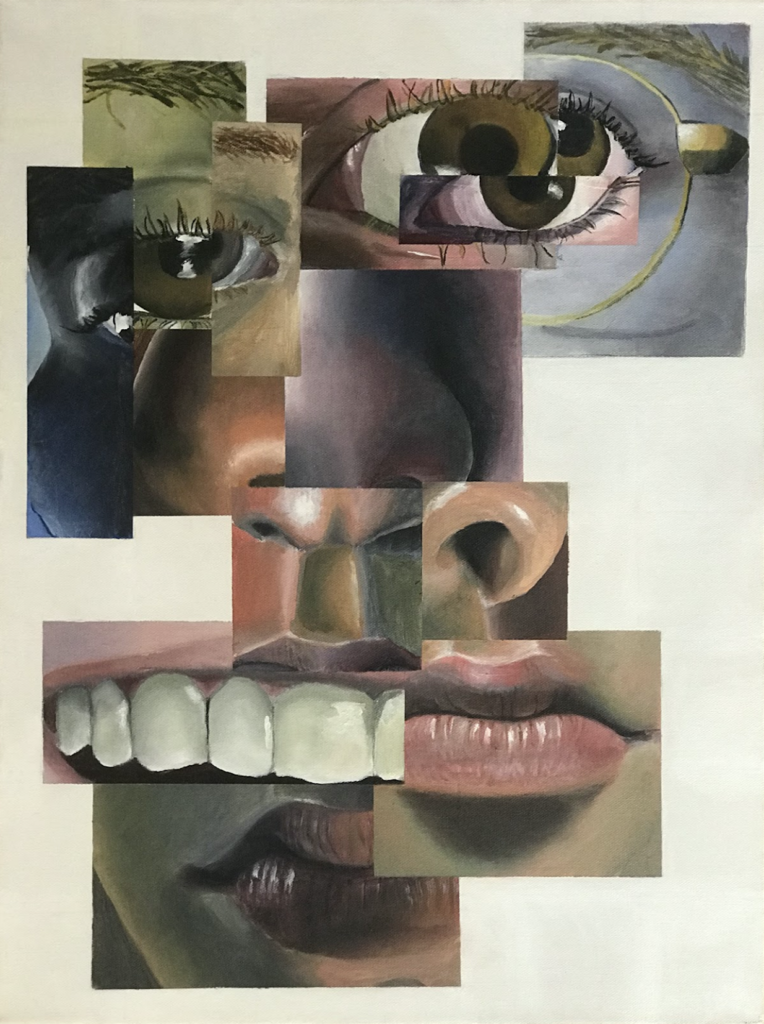
Painting by Caleb Ernst
ARTS 151 – Painting I: Acrylic This is an introductory course that consists of lectures and studio labs. This course focuses on both the acquisition of fundamental knowledge of acrylic painting, and the creation of paintings using one’s own unique imagery. Relevant art historical references and resources will be introduced in order for students to contextualize their work in reference to art history. Students will utilize critical thinking and problem-solving skills by doing progressively challenging assignments. As they work on these assignments throughout the semester, they will develop a more sophisticated aesthetic approach in the areas of color, composition, perspective, balance, and subject matter. There will be five class critiques (four critiques for each individual assignment and the last final critique for the entire course) throughout the semester and each student will have opportunities to discuss their work as well as the work of others.
This course is taught by Professor BG Muhn.
ARTS 154 01 – Intro to Watercolor
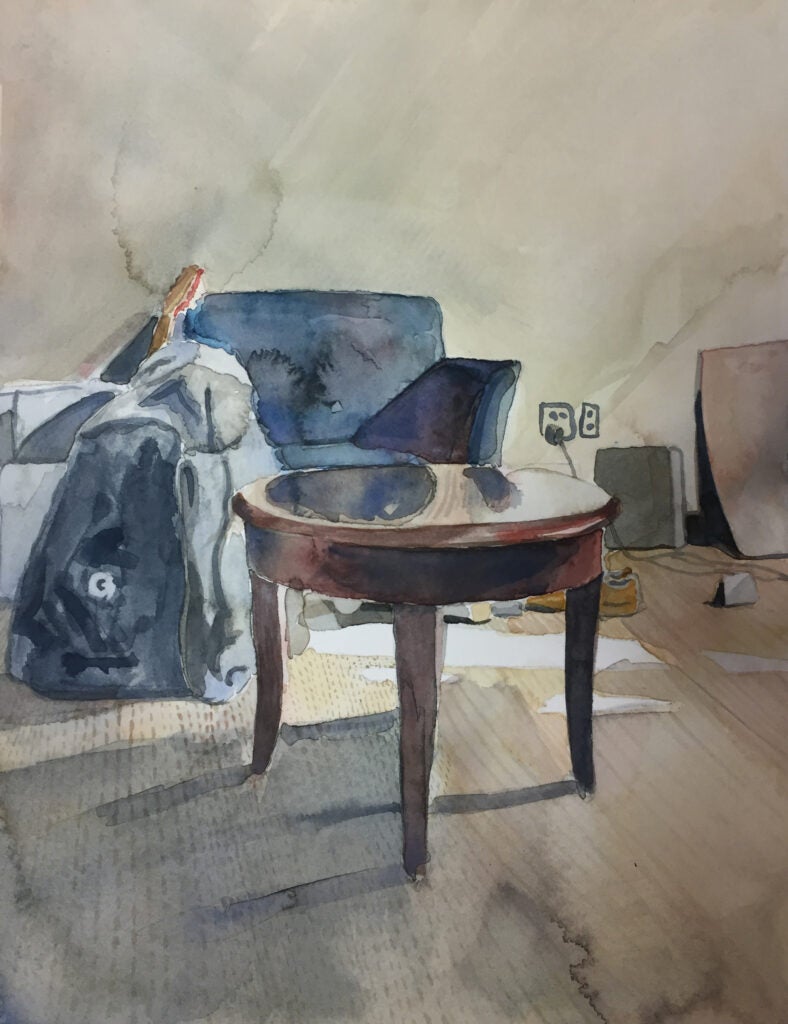
Edson Martinez.
Watercolor on paper.
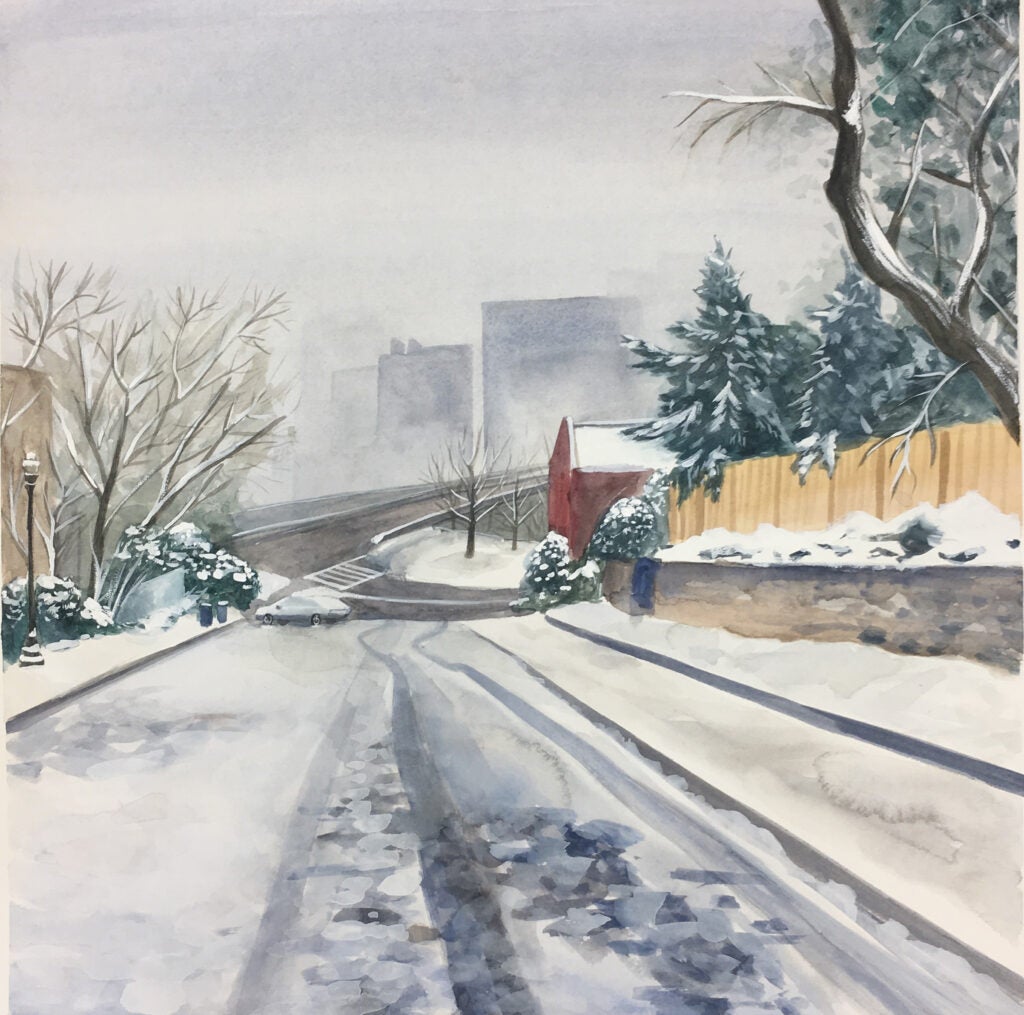
Danielle Deiotte.
Watercolor on paper.

Jack Wathieu.
Watercolor on paper.
ARTS 154 01 — Intro to WatercoloThis is a studio art class focused on developing the techniques and concepts of painting in traditional, water-based medium. Students will learn the basic techniques of transparent and opaque watercolor. They will investigate the impact of color and value on the illusion of space and form. While focusing on the traditional subjects of landscape, still life, and figure, they will create a portfolio of five images developing their drawing and painting abilities with the medium. Studio projects (watercolors), demonstrations, lectures, and; individual and class critiques will be conducted online using Zoom and Canvas to present all aspects of instruction — technique demonstrations, slide presentations and class discussion. Students create watercolors during regular class sessions for one-on-one feedback from the instructor and they continue to develop their paintings outside of class. The students receive individual guidance and evaluations from the instructor during each class as well as valuable insights from the student discussions during class critiques.
This course is taught by Professor John Morrell.
ARTS 250 — Painting Studio II

Jude An, Project 1: Conceptual Container

Christina Shoucair, Project 1: Conceptual Container

Sharon Huynh, Project 2: Human Body
ARTS 250 — Painting Studio II This is an intermediate-level painting course. The overall theme of the assignments for the semester is moving away from straight observational painting and exploring imagination and visual dynamism within a juxtaposition of the real and the unreal, blurring the boundaries between dream and reality and consciousness and the subconscious. This will be the overarching idea for all three projects while each project deals with a specific subject matter. Relevant references and resources will be introduced for students to contextualize their work using art history. Assignments begun in class will require time outside of class to develop and complete. Medium: either oil or acrylic.
This course is taught by Professor BG Muhn.
ARTS 252 01 — Watercolor & Ink
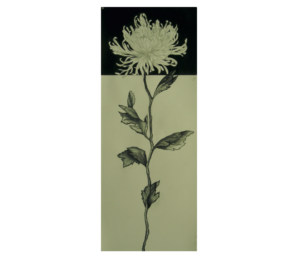
Student Work Spider Mum. 30 by 10 inches.
India and sumi ink, acrylic watercolor wash.

Instructor Work. Washington Cityscape. 30 be 40 inches.
India and sumi ink, acrylic watercolor wash.
ARTS 252 01 — Watercolor & InkPainting with water-based media crosses all great traditions, including East Asian, and European cultures. In European paintings, oil is the dominate choice, however, watercolor and ink wash are a close second. In contrast Chinese painting until recently primarily uses ink wash and watercolor. This class focuses on expanding techniques and aesthetics of painting and drawing. India ink, Sumi ink, Watercolor and Acrylic wash techniques using metal and bamboo pens as well as sticks and brushes will be investigated on both wet and dry paper. Emphasis will be placed on developing a strong graphic sensibility, line quality, tonal range and color individuality.
This course is taught by Professor John Morrell.
Graphic Design
ARTS 162-01 & 162-04 – Intro to Graphic Design
There are three sections of 162, at different times.

Dakota Access Pipeline protests, also called by the hashtag #NoDAPL .
Students had studies the bauhaus design and did research on the DAPL and created poster designs.

After learning the tools in illustrator and talking about branding and typography students design a logo, do variations and design business cards for the business and learn about the printing process. Work by Michelle Motta.
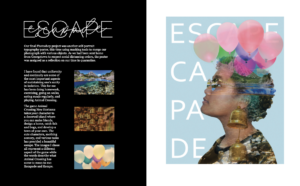
Students learn to do a portfolio newsletter in InDesign for their projects. This a spread from Nia Jordan’s portfolio.
Arts 162-01 & 162-04 — Introduction to Graphic Design: Students will learn the formal, aesthetic, and communicative aspects of creating effective graphic images. Projects include logos, typography, and digital arts that promote mastery of techniques, methods, and materials. In order to foster creativity, we start with breathing meditation at the start of class, followed by discussions about design and learn the Adobe software and the foundation of design principles. The goal of this class is to strengthen students’ visual literacy and communication skills as part of their liberal arts education.
This course is taught by Professor Negar Nahidian.
ARTS 162 03 – Intro to Graphic Design

Student multilingual print and interactive magazines based on chosen topic, major or minor

Chiara Lewis, translation drawings, pre-logo

Angela Perez, logo design and branding, laser etched and cut Maker Hub promo item
ARTS 162-03 — Intro to Graphic Design This is a studio art class focused on the creation of graphic design assets for print and screen-based media. During this course, you will learn basic Adobe Illustrator, Adobe Photoshop, and Adobe InDesign software through real-world projects and current topics in graphic design. The course seeks to familiarize design students with the communicative power of visual form and to help students develop a personal process of creating original graphic forms capable of effectively communicating a message or information. Projects integrate the following topics: principles of graphic design, design research, logos and branding, album cover design, interactive and print publication design, typography, graphic design history, and professional portfolios.
This course is taught by Professor Toni-Lee Sangastiano
Animation
ARTS 166-01 — Animation I

Screengrab from film by student Sarema Shorr
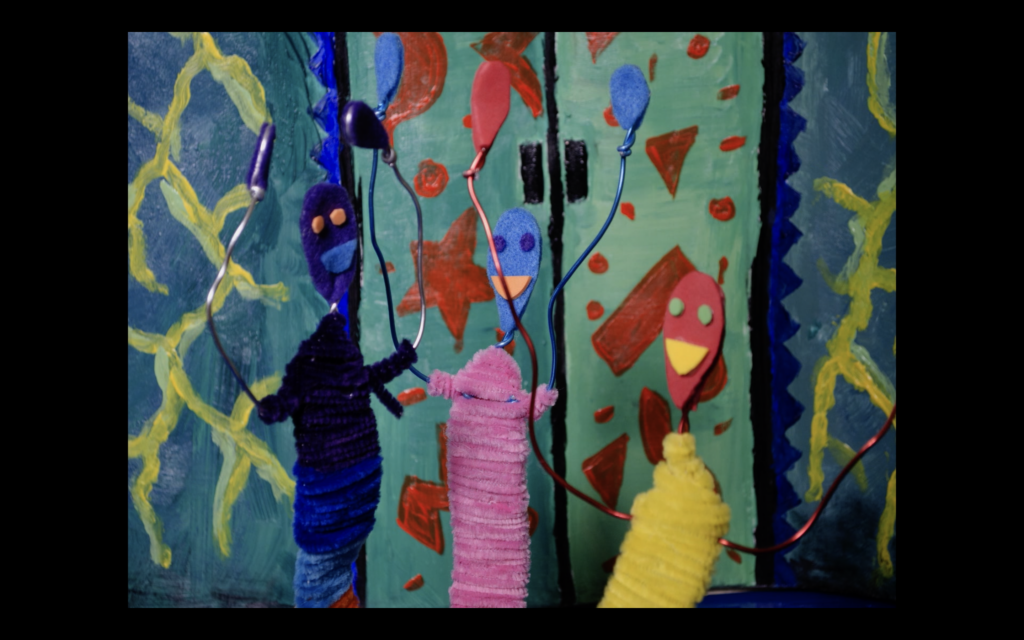
Screengrab from film by student Renata Garcia

Screengrab from film by student Shana Shin
ARTS 166-01 — Animation I This course is designed to introduce students to basic methods and practices in animation, while exposing them to artists working independently in the field. The course will provide an overview of techniques ranging from hand-drawn frame-by-frame animation, to object animation and pixilation. Each class will consist of a short demonstration, viewing of related works, hands-on experimentation and critique. Weekly assignments will further students’ exploration of animation approaches and techniques. The course will conclude with the creation of final projects in which students will develop and create an animated short in a medium of their choosing.
This course is taught by Professor Elyse Kelly.
Upper Level ARTS Courses
ARTS courses at the 330-400 level are designed primarily for Art Majors, Minors and advanced students who want to work with a professor on one or several independent projects over the course of the semester. These courses require approval. Please inquire with the individual instructor for more information.
These courses include:
ARTS 321 — Printmaking: Directed Study
ARTS 330 — Photography Studio III
ARTS 340 — Sculpture III
ARTS 350 — Painting Studio III
ARTS 430 — Photography Studio IV
ARTS 450 — Painting Studio IV
ARTS 499 — Senior Project Seminar
Art History Courses
ARTH 101-01 — Ancient to Medieval Art

View of the Roman Forum – taken in December 2019 by Prof. Tilney
ARTH 101-01 — Ancient to Medieval Art This course surveys the art and architecture from the Paleolithic period through the Gothic period. Within a roughly chronological structure, we will explore the art of these periods in relation to their broader cultural, intellectual and historical contexts. In addition to emphasizing the developments that define each historical period, we will consider the aesthetic advances made with the painting materials and methods available at the time.
This course is taught by Professor Barrett Tilney.
ARTH 102-01 — Renaissance to Modern Art
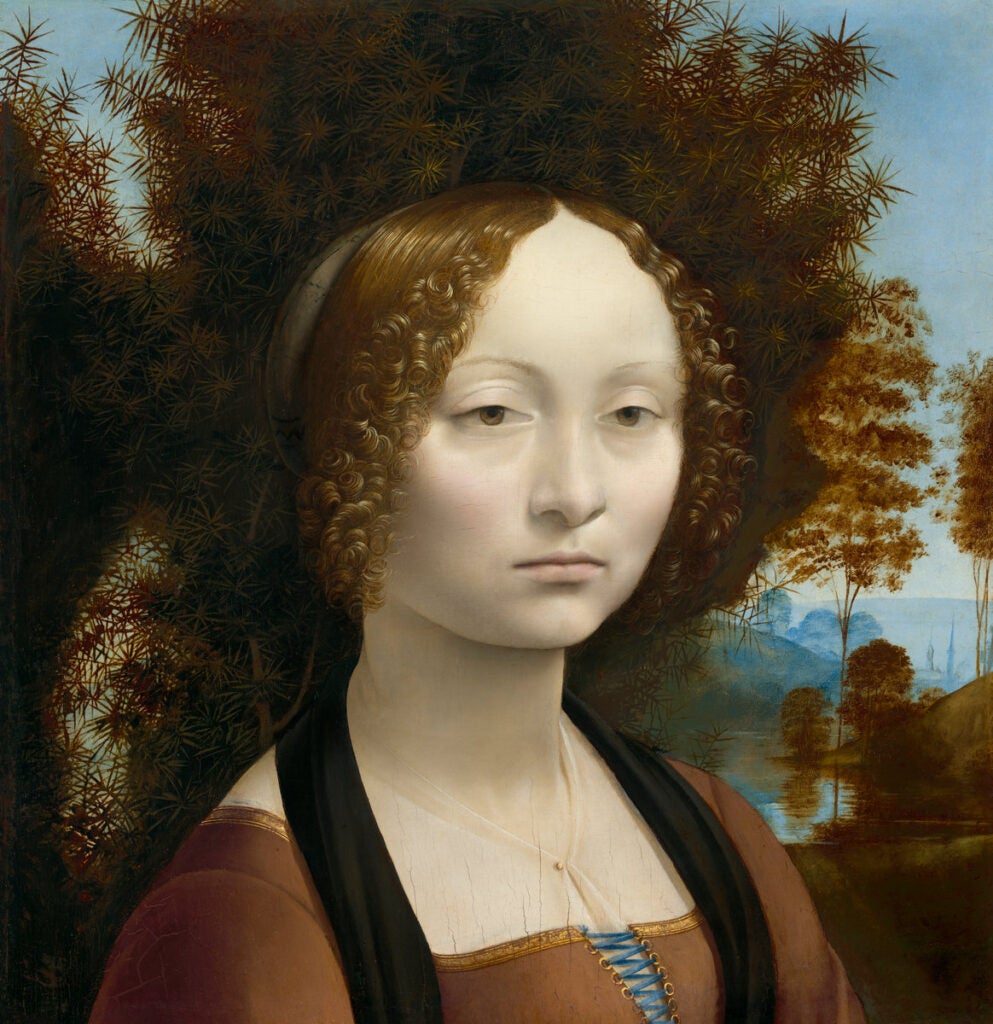
Leonardo da Vinci, Ginevra de’Benci, 1474/78
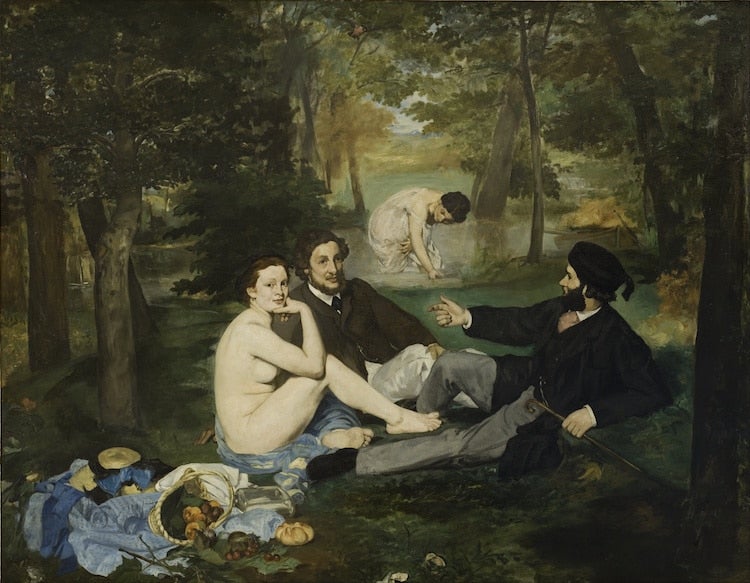
Edouard Manet, Lunch on the Grass, 1863

Eva Hesse, Hang Up, 1966
ARTH 102-01 — Renaissance to Modern Art This course surveys over six centuries of art to serve as an introduction to the history of Western culture, aesthetics, and civilization. During the semester, we will consider the work of major artists and artistic movements in the history of art from the beginning of the Italian Renaissance through the Modern era. The emphasis is on painting, sculpture, and architecture. The interaction of art and society will be explored through the chronological presentation of historical periods, permitting us to study the transformation of style and taste in relation to the changing culture and history of a particular time. The aim of the course is to provide a coherent framework for understanding the history of art in Europe and North America after 1300.
This course is taught by Professor Barrett Tilney.
ARTH 171-01 — Buddhist Art

Great Stupa at Sanchi, 3rd century BCE-1st century CE, Madhya Pradesh, India

Buddha in Parinirvana, Mogao Cave 158, Tang Dynasty (618-907), Dunhuang, Gansu Province, China

Hakuin Ekaku, “Two Blind Men Crossing a Log Bridge,” Edo Period (1615-1868), hanging scroll, ink on paper, Manyo’an Collection
ARTH 171-01 — Buddhist Art This course will survey the Buddhist art and architecture of Asia through selected case studies of artworks and sites in South Asia, Southeast Asia, and East Asia. Among the topics to be studied include: representations of the historical Buddha’s life, rock-cut architecture, monastic complexes, painted mandalas, Zen portraits, as well as the roles played by patronage, pilgrimage, and ritual. Our focus upon the Buddhist art and architecture of Asia will allow us to think through not only the historical development of the religion and its visual and architectural forms, but also issues of cross-cultural transmission. In the process, students will gain familiarity not only with the religious and historical context of the artworks and sites and with the basic iconography of Buddhist deities, but also with methods of visual analysis that form the basis of art historical methodology. No prior knowledge of Asian art or religions is required or assumed.
ARTS 252 01 — Watercolor & InkPainting with water-based media crosses all great traditions, including East Asian, and European cultures. In European paintings, oil is the dominate choice, however, watercolor and ink wash are a close second. In contrast Chinese painting until recently primarily uses ink wash and watercolor. This class focuses on expanding techniques and aesthetics of painting and drawing. India ink, Sumi ink, Watercolor and Acrylic wash techniques using metal and bamboo pens as well as sticks and brushes will be investigated on both wet and dry paper. Emphasis will be placed on developing a strong graphic sensibility, line quality, tonal range and color individuality.
ARTS 252 01 — Watercolor & InkPainting with water-based media crosses all great traditions, including East Asian, and European cultures. In European paintings, oil is the dominate choice, however, watercolor and ink wash are a close second. In contrast Chinese painting until recently primarily uses ink wash and watercolor. This class focuses on expanding techniques and aesthetics of painting and drawing. India ink, Sumi ink, Watercolor and Acrylic wash techniques using metal and bamboo pens as well as sticks and brushes will be investigated on both wet and dry paper. Emphasis will be placed on developing a strong graphic sensibility, line quality, tonal range and color individuality.
Northern Renaissance Art
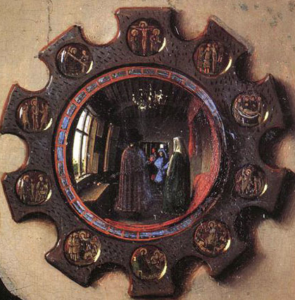
Jan van Eyck, Arnolfini Double Portrait (detail), 1434, London, National Gallery

Albrecht Dürer, Adam and Eve (detail), 1504, Washington DC, National Gallery of Art

Hieronymus Bosch, Garden of Earthly Delights (detail), c. 1510, Madrid, Museo del Prado
ARTH 228 – Northern Renaissance Art This course explores art made in the Netherlands, Germany, and France c. 1300-1575, which includes an amazing variety of work produced for courts, churches, civic bodies, and private individuals among growing middle classes in the cities. Who paid for art? How was it produced? What roles did it play in society, politics, religion, and daily life? Why did so many new kinds of subject matter emerge in European art of this period? With emphasis on the highly original and influential work of such leading figures as Jan van Eyck, Albrecht Dürer, Hieronymus Bosch, and Pieter Bruegel, we will consider functions, meanings, and markets of art in a period of dramatic change.
This course is taught by Professor Alfred Acres.
ARTH 255-01 — Global Contemporary Art

Yayoi Kusama, Pumpkin (1994)
ARTH 255-01 — Global Contemporary Art This survey course provides a general introduction to global contemporary art. After providing a brief grounding in 20th-century modernism and socio-political events of recent decades, this course considers a broad thematic range: pop and conceptual art; the emergence of performance, installation, and new media; earth works and site specificity; identity-based and institution-critical art; relational aesthetics and new modes of spectacle and digital consumerism; and the emergence of the global biennial and gallery system. This course assumes no prior knowledge and introduces students to a constellation of artists from around the world—from Cindy Sherman to Andy Warhol and Ai Weiwei, Lygia Clark to Kara Walker and Walid Raad, and many more.
This course is taught by Professor William Bourland.
ARTH-259 — Exchange in the Medieval World.

Madapa map with detail of Jerusalem (6th century CE) mosaic, Church of St. George in Madaba Jordan.
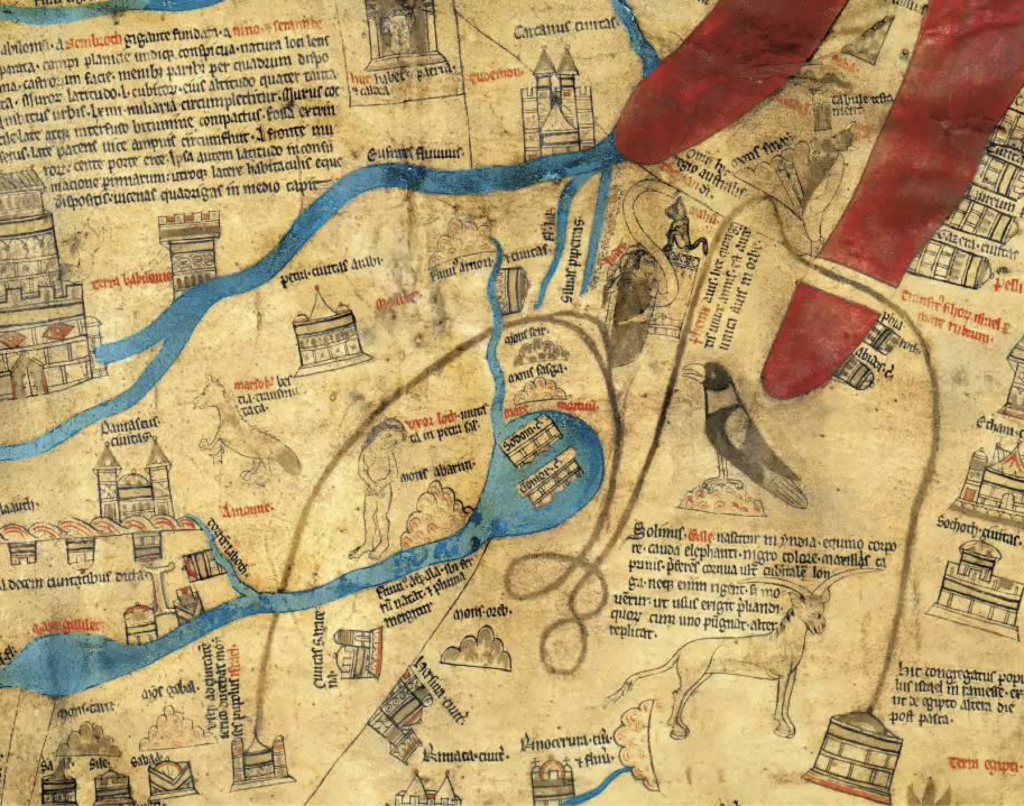
Hereford Mappa Mundi (c. 1300) velum (1.59 x 1.34 meters) Hereford Cathedral, United Kingdom.

Cresques Abraham, Catalan Atlas (1375) painted vellum with gold and silver (14 sq feet) Bibliotheque Nationale, Paris.
ARTH-259 — Exchange in the Medieval World Globalization in the medieval period casts a long shadow across art history, spanning from the rise of the Byzantine emperor Justinian (527 CE) to the Sack of Constantinople (1204 CE) and the Siege of Acre (1291 CE). During this period the transportation of material goods, circulation of artistic practices, and mobility of ideas across geographies led to networks of connectivity between Constantinople and Rome, Jerusalem to Aachen, and Granada to Cairo. This course examines how art objects (painting, sculpture, textiles, manuscripts, ivories, enamels, and relics) and architecture allow us to recover and retrace cross-cultural movements both within a European context and beyond. Students will consider issues of patronage, messaging and propaganda, race and cultural migration, trade routes and mechanisms of exchange, and the dynamic rise of artistic capitals.
This course is taught by Professor Tiffany Hunt.
ARTH 351 — Radical Art. Russia/East Europe
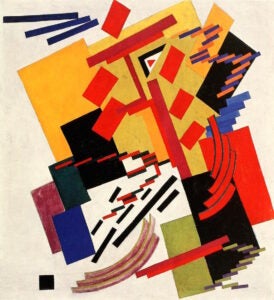
Olga Rozanova, Non-Objective Composition. Suprematism (1916)

Karel Teige et al., typophotomontage from ABCs (1926)

Ekaterina Maksimova (architect) et al, Factory Kitchen (1931)
ARTH 351 — Radical Art. Russia/East Europe This course investigates the experimental art of Russia and Eastern Europe in the first decades of the 20th century in a comparative context. Our aim is to examine the commonalities among the diverse radical groups that identified themselves with “the avant-garde,” to consider how avant-garde artists defined their place in society and negotiated their relationship to politics, and to reflect on the position of experimental artists from this geographic region within broader European trends. We ask: what distinguishes the avant-garde from other modernist trends? Can we speak of a unified international movement known as “the avant-garde,” or are there many avant-gardes? What is the relationship of the avant-garde to nationalism, cosmopolitanism, and internationalism? Where does the avant-garde stand in relation to socialist revolution and leftist politics? We consider these and other questions by interrogating the avant-garde’s relationship to the past, history, and tradition, and by examining the techniques, media, and genres that were pervasive throughout its different factions. The media include: painting, poetry, artist’s books, performance, photomontage, film, architecture. Movements covered: Futurism, Dadaism, Constructivism, Surrealism & others. For the final students have the option to pursue a creative project that engages avant-garde techniques and strategies studied in the course.
This course is taught by Professor Irina Denischenko.
ARTH 366-01 — Latin American Art II

ARTH 366-01 — Latin American Art II The course provides an in-depth analysis of Latin America through the art of Diego Rivera, Frida Kahlo, José Clemente Orozco, David Alfaro Siqueiros, Rufino Tamayo, Maria Izquierdo, Xul Solar, Antonio Berni, Wilfredo Lam, and Fernando Botero among others. By analyzing a wide variety of artistic production that includes painting, sculpture, performance, prints, manifestos, music, film, and ephemera, the course considers the diversity of Latin American cultural and artistic production, emphasizing artists’ relationship to religion, tradition, race, gender, and politics. While considering Latin America’s enduring legacies and dynamic processes of change, it addresses several important art movements, such as modernism, surrealism, indigenism, social realism, muralism, and magical realism. Moreover, the course introduces students to the major artistic theoretical issues with an eye on the regional and global changes that defined, challenged, or helped shape Latin American art and culture.
This course is taught by Professor Andrea Gallelli Huezo.
ARTH 430-01 — GU: Architecture & History
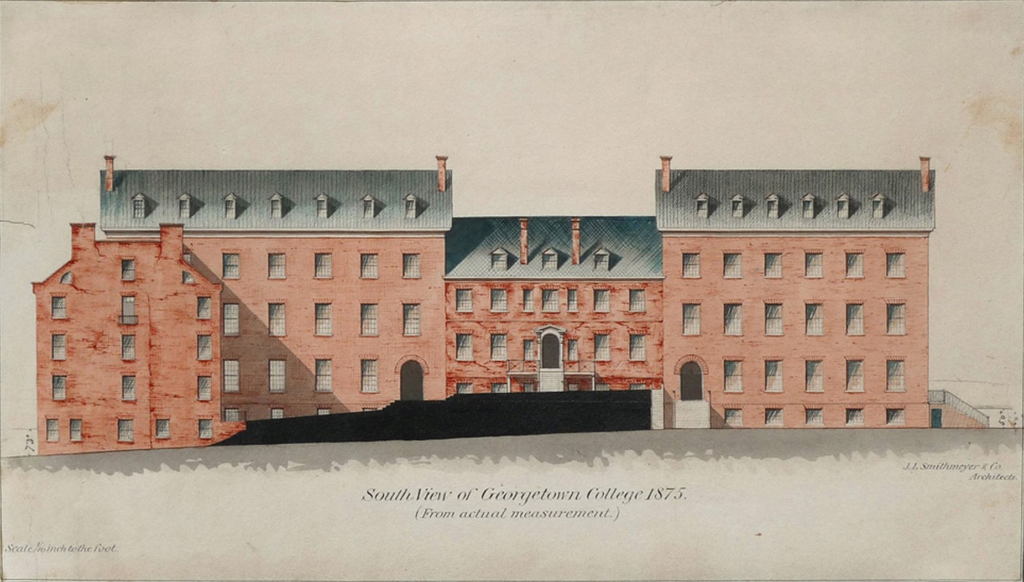
Smithmeyer & Co. Southview of Georgetown College. Ink with watercolor on paper. 1875
Source: Georgetown University Art Collection, Lauinger Library, Booth Family Center for Special Collections, Washington, D.C. 1111.1.959
ARTH 430-01 — GU: Architecture & History This seminar will provide an in-depth look into Georgetown University’s architectural development over time. Beginning in the eighteenth century and moving to contemporary campus developments, students will explore iconic buildings and landscape changes. Among the many structures we will investigate are Dahlgren Chapel, Healy Hall, Isaac Hawkins Hall, the Car Barn, Observatory and Lauinger Library. Structures will be studied within their cultural context with issues relating to the country’s broader political environment, university leadership and slavery playing a role in our study. We will also note various unrealized campus building plans. Wider developments in American university architecture will be discussed. This course will provide students with an outstanding practical research experience as our work will parallel the development of a Georgetown campus guidebook. This course requires no prior knowledge of architectural history and will introduce students to general building styles via university examples.
This course is taught by Professor Stephanie Rufino.
ARTH 454-01 — Art & Poetry

Landscape with the Fall of Icarus
by William Carlos Williams
1960
ARTH 454-01 — Art & Poetry This seminar examines the complex relationship between art and a certain kind of poetry, called ekphrasis. Departing from the Roman poet Horace’s (65 B.C.E. to 8 B.C.E.) observation, “Ut Pictura Poesis,” (as is Painting so is Poetry), we will study ways in which poets have written about works of visual art that inspire them to respond in their own artistic medium of words. The class will investigate the history of this phenomenon, tracing how the established traditions or parameters of the relationship between painting and poetry have been accepted or rejected over time. We will also consider the 19th-century notion of “Ut pictura musica.”
In addition to critical readings, discussions, guest appearances by poets, and a session with the curators from Special Collections to study original works of art, students will compose ekphrastic poems and create their own projects at the end of the semester.
This course is taught by Professor Elizabeth Prelinger.
ARTH 455 — Art of the Black Atlantic

Kerry James Marshall, Gulf Stream (2003)
ARTH 455 — Art of the Black Atlantic This course considers the ways in which blackness—in both a racial and chromatic sense—has operated in the history of visual culture and its critical-aesthetic discourses. On one hand, this means questions of “value” and symbolic meaning in the construction of “western art history,” and the myriad formulations of specific Black or Black Atlantic arts; on the other hand, we will consider the ways in which debates around identity and political collectivity effect forms of practice that challenge the boundaries of location, medium, memory, and cultural politics.
This course is taught by Professor William Bourland.
ARTH-482 — Ideas of Realism

Vincent Desiderio, Cockaigne, oil on canvas, 13′ x 9′, Hirshhorn Museum and Sculpture Garden, Washington DC
ARTH-482 — Ideas of Realism This seminar explores shifting means and ends of naturalistic representation, with an emphasis on work produced in Europe and the United States between the Renaissance and the present. Rises, falls, detours, and re-imaginings of “realism” across the centuries have been regarded in surprisingly few and often conventional ways. Through case studies of specific works and discussion of primary and secondary texts, we will try to recover some of the strange energies of an impulse whose ambitions and strategies (in art, literature, theater, film, etc.) are too often taken for granted. Our class will make at least two visits to local collections.
This course is taught by Professor Alfred Acres.
Senior Thesis
ARTH 490, Senior Thesis: By arrangement with a faculty adviser, majors may write a senior thesis on an art historical topic of their choosing. The thesis is optional but can serve as a capstone course that prepares students for future professional or graduate work.
Art & Museum Studies Courses
AMUS 500-01 — Museum Studies Foundations
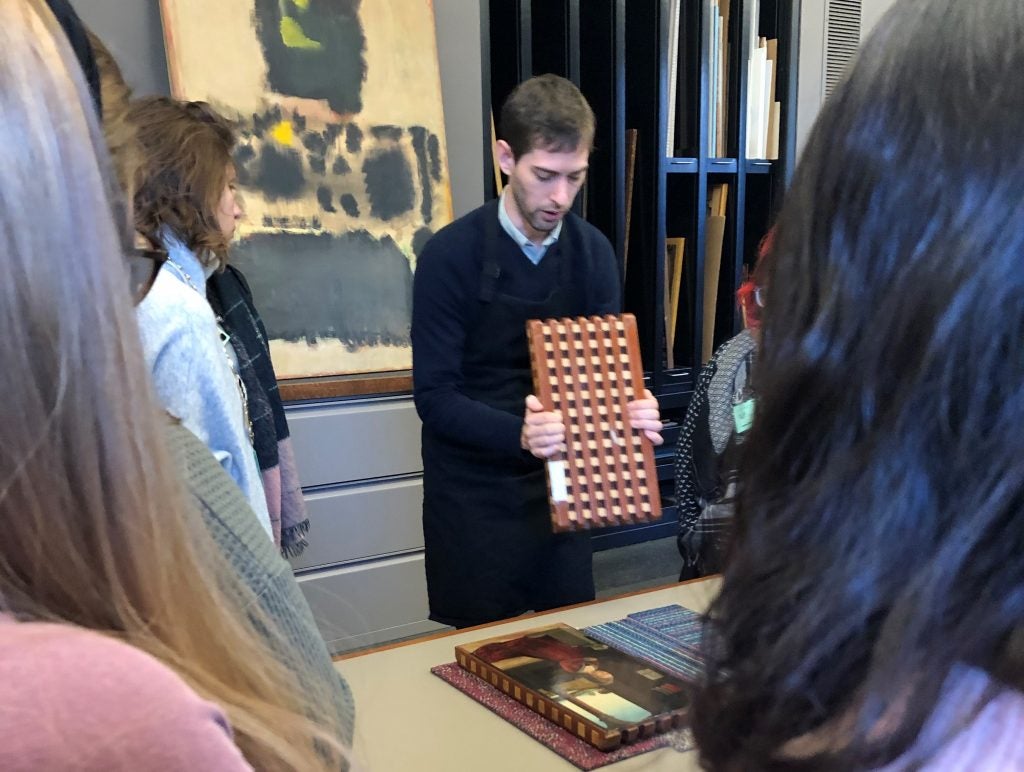
Students in Museum Studies Foundations visit a conservation laboratory
AMUS 500-01 — Museum Studies Foundations This course introduces students to the state of museums as well as their core functions, history, and critical literature. We will examine recent debates about museums through the lens of gender studies, disability studies, critical race theory, decolonization, and environmental sustainability, with particular attention to social media movements currently calling for change. Assignments will focus both on mastering key concepts in museum studies and on considering how we can change museums to better fit society. Our focus will be on art museums, but selected topics in historic and ethnographic museums will also be considered.
This course is taught by Professor Lisa Strong.
AMUS 510-01 — Collections Management
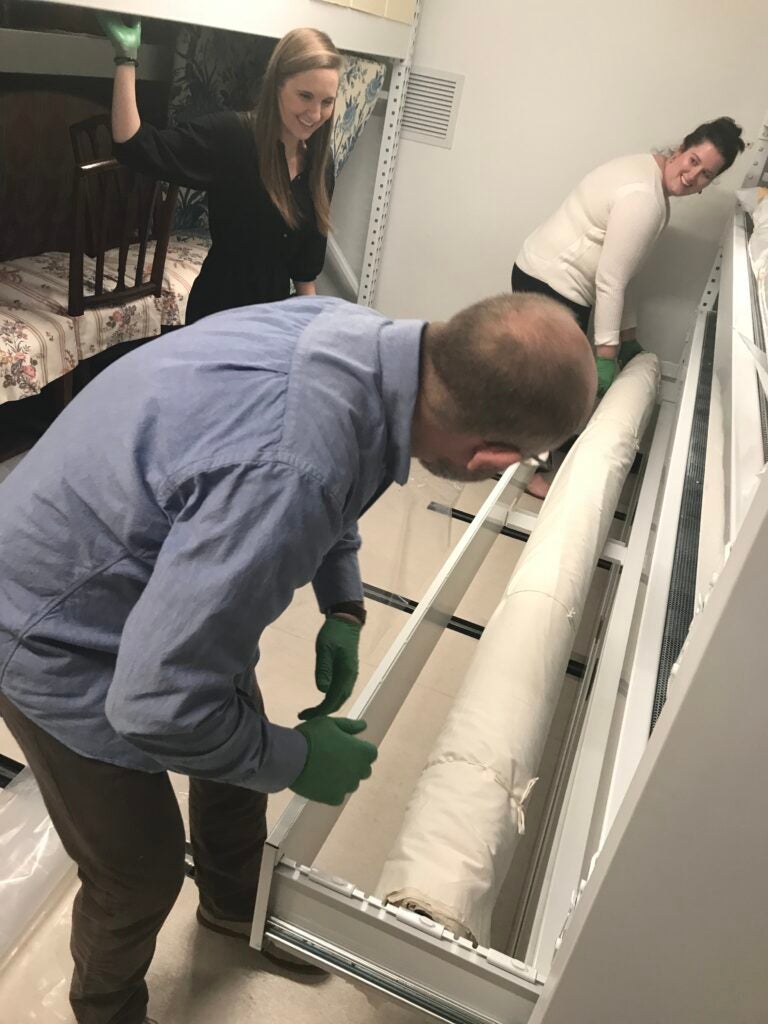
Proper handling of objects

Understanding the objects in the collection

Proper storage techniques
AMUS 510-01 — Collections Management This course focuses on general museum concepts and procedures as they relate to collections (objects and their documentation) and their management (e.g., preparation, preventive maintenance & conservation, housing, problem solving) as a whole. The course objectives are to introduce the participants to basic care and preservation of collections as well as a basic understanding of the history and current status of the governance of cultural materials. By the end of the course, participants should understand the definition and role of collections within a museum context; understand the philosophy of cultural preservation and the meaning of cultural patrimony; understand the importance of collection ethics and the role of collections within museum accountability and accreditation programs; understand the importance of a collections management policy, its development, content, and application; and how such a policy governs the daily activities within a museum’s collections.
This course is taught by Professor Jerry Foust.
AMUS 520-01 — Museum Education and Interpretation
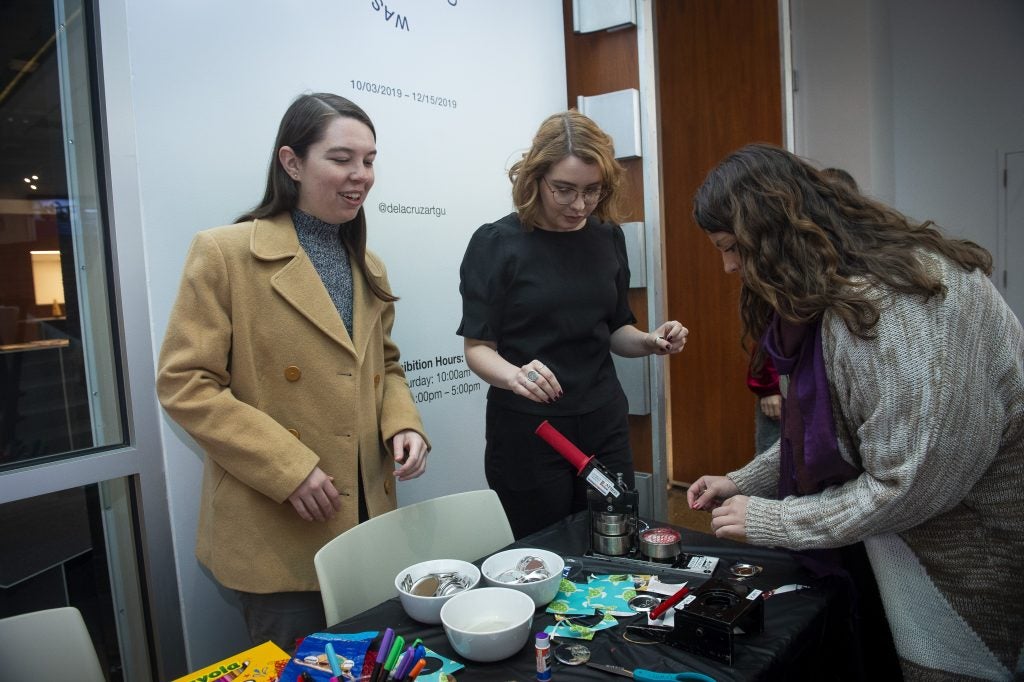
Students in Museum Education and Interpretation prepare for a program at the Maria & Alberto de la Cruz Gallery, 2019.
Copyright ©2019 Lisa Helfert for Georgetown University.
AMUS 520-01 — Museum Education and Interpretation Students will be active participants in learning about museum education theories and practice. This course situates the functions of museum education and interpretation within the broader context of a changing paradigm in museums. During site visits to area art museums, educators will discuss aspects of interpretation, programming, and research that are unique to their museum. Class discussion will include such topics as how visitors learn in an art museum, new approaches to interpretation, education programming for varied audiences, building audiences and community, and the relationship of mission to education and interpretation.
This course is taught by Professor Anna Hindley.
AMUS 530-01 — Fall Internship

An Art and Museum Studies student installs her exhibition at Booth Family Special Collections, Georgetown University
AMUS 530-01 — Fall Internship Museum internships provide concentrated practical experience within selected museum departments as well as an overview of the operations of a museum. Some of our internships include a staff-directed seminar; most involve a linked research project as well as an internship journal. Expectations and placement will be discussed during the orientation session. Schedule determined by student and museum supervisor; 15–20 hours/wk. Art and Museum Studies students only.
This course is taught by Professor Lisa Strong.
AMUS 535-01 — Curatorial Studies
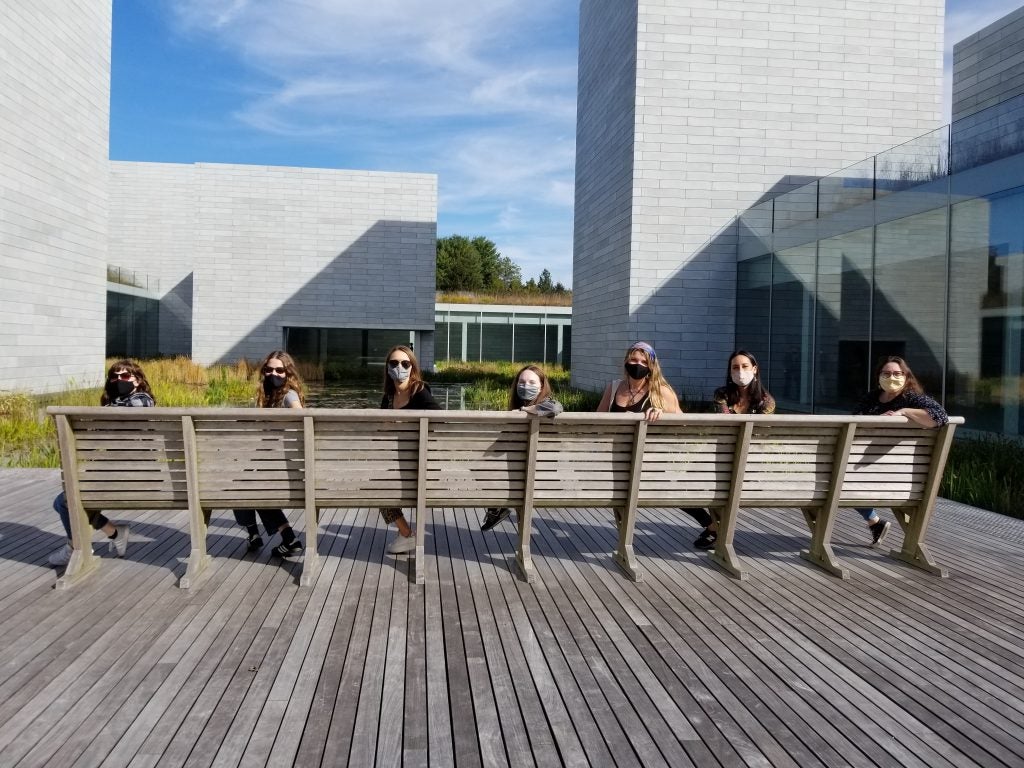
Class site visit to Glenstone Museum, 2020

Students in Georgetown’s Maria & Alberto de la Cruz Art Gallery

Students in Georgetown’s Maria & Alberto de la Cruz Art Gallery
AMUS 535-01 — Curatorial Studies The term “curate” has become ubiquitous in popular culture. Professional curators are doing the real work and exist at the heart of the art world; however, their role and daily responsibilities remain mysterious to many. This introductory course will encourage students to know the history of the curatorial field, think critically about the discipline as it exists and is evolving today, and acquire practical skills and knowledge for jobs in the curatorial sector with a focus on the institutional environment. During the semester, we will examine collections and exhibitions from the curatorial perspective. Lectures, assignments, readings, in-class exercises and site visits/guest lectures with local curators will explore both aspects. Students will also be expected to visit museums on their own as some class assignments will stem directly from this visual experience. The course will culminate in the production of each student’s own exhibition proposal for a Washington, DC museum.
This course is taught by Professor Kevin Tervala.
AMUS 545-01 — Museums and Digital Media

Digital and digitized objects from the Smithsonian collection.
AMUS 545-01 — Museums and Digital Media Within the span of just a few decades, digital technologies have made a profound impact on museums: from how they operate to how the visitor experience is constructed. With an emphasis on interpretation and outreach, this course will explore the impact of technology on museum approaches to collections, exhibitions, and education. A variety of digital media platforms will be covered, including websites, social media, in-gallery interactives, and mobile experiences. We will immerse ourselves in key issues that guide and frustrate the successful implementation of technology in 21st-century institutions, such as openness, collaboration, sustainability, and a focus on the museum audience as user. With the help of case studies and guest speakers, we will explore what’s possible—and what’s challenging—when it comes to museums and technology.
This course is taught by Professor Darren Milligan.